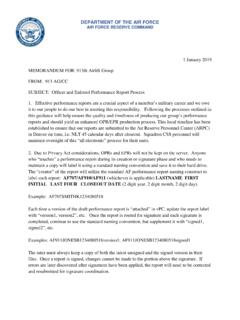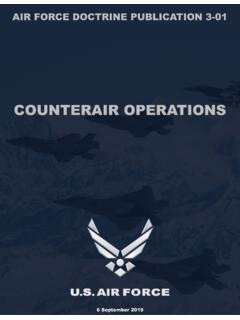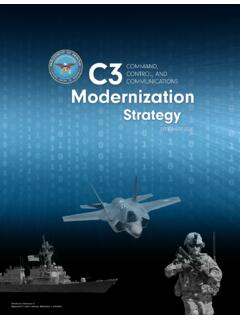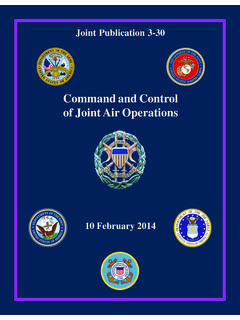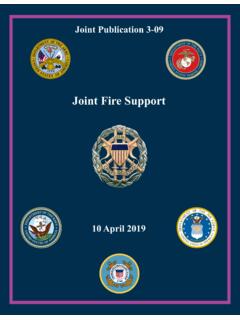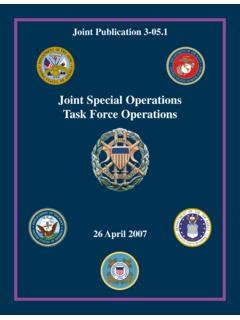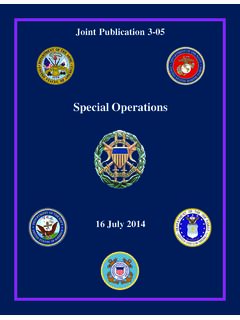Transcription of Introduction and Fundamentals of Joint Terminal Attack …
1 Requirements: UO familiarization course or equivalent Ability to use the ACRE radios Map reading ability, including 8 digit grids, reading contour lines and recognizing terrain features A working game, I am not going to play tech support. Ability to ask questions when confused Introduction and Fundamentals of Joint Terminal Attack control Start Welcome (5-7 mins) What is this course? By the end of this course you will be able to control fixed and rotary wing aircraft in game so that they provide safe, effective fire upon enemy positions. You will be able to properly help your team utilize the full potential of an Attack aircraft. Most players do not know how to properly control an attacking aircraft in a forward area - this tends in air missions which are ineffective, slow to arrive and often contain an elevated risk of fratricide. Introduction re: Chris Krause Do not have military experience I do not claim to be an expert on this topic, only a amateur and academic Most of the information in this course is based upon my experience reading field manuals and studying fully modeled flight simulators.
2 I have a list of resources from which I based my knowledge which I can make available to you. You can and should ask questions Native english speaker. This is a small class, so we have time for questions. If you don t understand something you must ask for clarification Not understanding = killing friendlies with assets or not being effective If you want anything in particular covered that is not on the syllabus, I am open to suggestions The course contents are as follows: First: a brief Introduction to close air support, definitions, what you should be able to do by the end of this course, special equipment, procedures for the execution of close air support requests. Two: Practice with special equipment, map tools and CAS requests. Third: A practical segment which you must complete before I will endorse you as having taken this course. The practical is a scenario in which a Tactical air control party must stop a Russian mechanized wave Attack on a friendly AI force of light infantry.
3 If you don t support them, they will die. You will use your new skills as a Joint Terminal Attack controller, or JTAC, to accomplish this. Fourth: A debrief, in which I will cover any topics you are interested in, will take feedback from you and conclude the course. This course should run about 3 hours. This course will only cover the Fundamentals of Joint Terminal Attack control - it is outside the scope of our time frame to teach you everything. If you take anything away from this class hopefully it will be an understanding of what a type 1, type 2, type 3 CAS request are - how to do a 9 line and how to use special equipment of the JTAC. If you have that roughed out, the rest will come with practice or study and you ll be more proficient in this than the vast majority of the players here. One note: this course covers air control as it applies to the US armed forces, in particular the army. Some notes will be offered on Marine corps and NATO cooperation.
4 What is the JTAC? (10 mins) term gets thrown around a s the guy who controls and calls in Attack aircraft, explain typical presence in missions is a JTAC in reality? JTAC = Joint Terminal Attack controller Extension of the historical army forward observer. But JTAC has a much more rigorous and in-depth training. JTACs are either army or air force personnel. The JTAC MOS only became active in the US military in 2003. They typically function in two formations: tactical air control parties: The TACP is the principal Air Force liaison unit collocated with Army maneuver units from BN through corps. It consists of two JTACs, a forward observer and a air force liaison officer. The TACP has two primary missions: advise ground commanders on the capabilities and limitations of air operations , and provide the primary Terminal Attack control of CAS. TACPs coordinate air combat missions and deconflict the aircraft with Army fire support.
5 TACPs are organized into expeditionary air support operations groups or squadrons that are aligned with their respective Army corps, division, or brigade HQ. TACPs may employ JTACs at the company/team level. Terminal Attack control teams which are two man teams consisting of a JTAC and a JTAC apprentice. The marine corps does not have JTAC in name, although their forward observers are certified as JTACs. The official definition of a JTAC is as follows: The JTAC is the forward Army ground commander s qualified (certified) Service member, who, from a forward position, directs the action of combat aircraft engaged in CAS and other air operations in the ground commander s operational area. JTACs provide the ground commander recommendations on the use of CAS and its integration with ground maneuver. The JTAC must: Know the enemy situation and location of friendly units. Know the supported commander s target priority, desired effects and timing of fires.
6 Know the commanders intent and applicable ROE. Validate targets of opportunity. Advise the commander on proper employment of air assets. Submit immediate requests for CAS. control CAS with supported commander s approval. Deconflict aircraft and fires from CAS sorties. Provide initial BDA JTAC knows how to conceal himself, conduct observation, call in close air support safely and without error. It is difficult or impossible to do close air support properly without a proficient Joint Terminal Attack controller. anyone not understand what the JTAC is, or what he does? Close Air Support (30 minutes) Close air support (CAS) is air action by fixed-wing and rotary-wing aircraft against hostile targets that are in close proximity to friendly forces, and requires detailed integration of each air mission with the fire and movement of those forces. The JTAC directs CAS. CAS is implemented in three phases [GO OVER NAMES FIRST, THEN READ DESCRIPTION].
7 Planning Receipt of mission: Read the briefing. Mission analysis Understand higher s fire support plan: you may need to call in artillery to mark a target, you will need to deconflict your aircraft from other fire support assets Understand air threats - ranging from heavy machine guns, to man portable surface to air missiles, to anti-aircraft artillery and fully developed SAM systems. Understand the commander s intent, maneuver plan and the approximate location of friendly forces at all stages of the operation Understand restrictions, taskings, and capabilities of CAS aircraft High value targets Rules of engagement Command and signals Course of action development/analysis Develop a plan to employ CAS to achieve the commander s intent and the tactical realities. Designate OPs for JTAC Integrate triggers with maneuver. - restrictions on CAS dependant on the movement of friendly force Movement plan for the TACP or TACT Allocate fire support assets Designate restricted air space etc Aircraft/pilot abilities, limitations and operating abilities Air threat posture analysis Orders production Commander approves plan for CAS.
8 Preparation Movement Move to OPs Execute maneuver plan. Observation Observe targets Observe areas of interest Execution Execution Track friendly units Observe triggers Scan for air threats and enemy movements Deconflict/coordination fires Execute CAS requests on targets of opportunity Reality vs game: in reality you would be working with a tactical operations center, in game you have free reign to call in CAS without considering theatre-wide demands and developments Determine type of control needed Once the CAS is on station: Aircraft check in CAS briefing (9 line) CAS Attack Depart initial point Mark targets Confirm target/marks Weapon release request Weapon cleared hot Weapons release Assessment BDA/assessment Further tasking Re- Attack Return to initial point or battle position Depart We are going to briefly go over all of this, because if any of these steps are missing from close air support deployment, problems can result.
9 CONDITIONS FOR EFFECTIVE CLOSE AIR SUPPORT EFFECTIVE TRAINING AND PROFICIENCY Both pilots and JTAC need to have a basic ability to understand the nuances of close air support (as outlined above) PLANNING AND INTEGRATION If you don t plan what you are doing with moving friendly forces, you will kill them. COMMAND AND control Can you contact and control the aircraft? AIR SUPERIORITY CAS in an area contested by enemy aircraft is dangerous and ineffective. TARGET MARKING If you mark a target, and the pilot is able to contact the mark - fratricide is reduced and effect is increased STREAMLINED AND FLEXIBLE PROCEDURES In ARMA 2 terms, this refers to the freedom of the TACP/TACT to move away from the main body of the friendly forces and to conduct observation. IN addition, it involves that both the observer and the weapon operator are on the same page. APPROPRIATE ORDNANCE Some weapons won t do the job, some weapons may endanger friendly forces.
10 FAVORABLE ENVIRONMENTAL CONDITIONS Don t do CAS on a mission with less than a 3000 meter visibility. In reality CAS never flies when there are sand storms or blizzards. We could spend hours on each one of the phases of CAS, so let s break down into an ultra minimal form so you guys understand the basics: Planning: Read the mission briefing, copy and understand what aircraft will be available, what can shoot them down, the enemy threat and how you will use your aircraft to destroy that threat or otherwise achieve the commander s intent. Give aircraft initial orders: get airborne and come on station at IP ford. Determine where you will be during the mission, make sure you can observe friendly movement and enemy forces. Get confirmation from the commander. Preparation: In game now, you will establish coms with your aircraft, get an ordnance check, confirm they are inbound, set up your radios and begin movement to an observation post.
